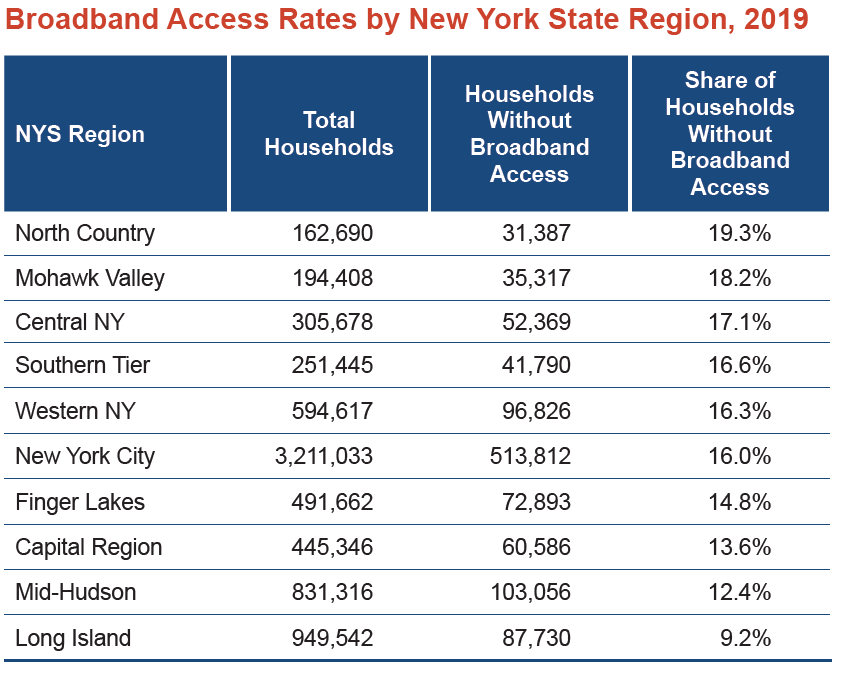DiNAPOLI: OVER ONE MILLION NEW YORK HOUSEHOLDS ARE NOT CONNECTED TO BROADBAND
Developments at Federal Level Provide Opportunity to Improve Availability, Access and Affordability

The state has made progress in making high-speed connections available to New Yorkers, ranking second in the U.S. in the percentage of the population with broadband available in their neighborhood, but more than one million, or 13.8%, of households do not have access or a subscription to home broadband services, according to a report released today by State Comptroller Thomas P. DiNapoli.
“Reliable, high-speed internet is a necessity to effectively work, communicate and learn in our society and that was made crystal clear during the COVID-19 pandemic when millions of New Yorkers turned their homes into schools and workplaces,” said DiNapoli. “The state has taken significant steps to make broadband available to most New Yorkers, but there is still a digital divide in rural parts of New York and for low-income New Yorkers who don’t have access or are unable to afford a home subscription. High-speed connections are an imperative for economic development and equal opportunity.”
DiNapoli’s analysis finds many predominantly rural areas remain underserved by broadband infrastructure. In addition, approximately 1 in 3 New York households with income less than $20,000 lacked access to broadband at home. As of 2019, the greatest share of households lacking access was in New York City.
Only a limited number of households had higher-speed subscriptions that were essential during the pandemic, as stay-at-home orders led to sharply increased amounts of data transmitted simultaneously. While 86.2% of New York households had access to broadband at speeds of at least 25/3 megabits per second (Mbps), only 13.5% of those had home broadband subscriptions at faster speeds of at least 250/25 Mbps in 2019.
Some households upgraded their subscriptions to accommodate increased demands within their homes during the pandemic; however, other New Yorkers may not have had that option due to a lack of availability of higher-speed connections or affordability concerns. While the pandemic highlighted these disparities, enhancing broadband is important not only for equity but also for long-term economic competitiveness.
DiNapoli urged the state to craft a detailed strategy that can leverage federal funding provided under the American Rescue Plan and new funds that may be provided under the infrastructure bill currently before Congress. He said the plan should:
- Accelerate universal availability of the highest speed connections, including in rural areas where there are currently no providers or only one option for service. The state should look to the future and plan for the deployment of gigabyte (1000 Mbps) connections. This will require both upgrades to current infrastructure systems, as well as deployment of new technology;
- Enhance access for low-income households. Solutions should focus on both residential properties and community institutions, including schools, libraries and parks; and
- Improve affordability, particularly for low-income residents. 326,000 households in New York have already benefited from the Federal Communication Commission’s (FCC) Emergency Broadband Benefit Program, which currently provides a $50 per-month subscription subsidy and a one-time discount on a computing device. State leaders should advocate for it to be extended or made permanent during the ongoing federal infrastructure negotiations.
Broadband Availability
New York has done well in deploying broadband infrastructure at the standard speed of 25/3 Mbps. In 2019, the state ranked second in the country with 98.7% of the population in areas with broadband compared to a national average of 95.6%, according to the FCC. At least one provider offering high-speed broadband of at least 250/25 Mbps speeds was available to 98.3% of New York’s population; however, provider competition is lacking, which may make consumer costs higher.
The report noted that the FCC considers an area “served” if a service provider reports that it has made broadband infrastructure available to a particular census block, even if service is not necessarily available to every location on that block. As a result, these figures may overstate broadband availability, but remain the best data available on infrastructure deployment.
The state’s deployment of broadband infrastructure has reduced the number of New Yorkers without broadband available from a reported 518,000 to 253,000 people between 2013 and 2019.
Key findings:
- Approximately half of those without broadband available were downstate: Long Island (25%), New York City (12%) and the Mid-Hudson Valley (12%).
- The Capital Region had the lowest number of people in the state without broadband available at 3%, or approximately 6,000 people.
- Broadband was not available to 1.3% of New York’s population. Regionally, this varied from a high of 5% in the North Country to a low of 0.4% in New York City.
- Availability rates were lowest in counties with greater shares of population living in areas classified as rural. Counties with the highest percent of population without broadband available were Allegany (23.4%), Cattaraugus (17.9%) and Hamilton (14.7%).
Broadband Access
While broadband availability indicates a geographic area has been wired for that service, access to broadband indicates that a household has a subscription for services, including cellular service. In New York, the gap between availability and access was significant: while about 253,000 people did not have broadband available in their neighborhoods, over 1 million households, or 13.8%, did not have access or a subscription as of 2019. Almost half of all households without broadband access were in New York City.
Posted: September 14th, 2021 under Adirondack Region News, Business News, Northern NY News, Peru/Regional History, State Government News.
